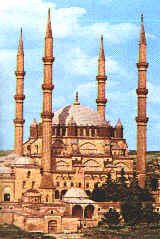|
|
The rolling hills and sunflower fields of Thrace comprise European part of Turkey, cut off from Anatolian heartland in Asia by Dardanelle, Sea of Marmara and Bosphorus.
Standing at the gateway of East is Edirne, dominated by one of the masters of Ottoman art, Selimiye Mosque. Its four great minarets stab the skyline and mark the transition from Occident to Orient.
At the demarcation line between East and West, Marmara region has turbulent past. It was from ancient Abydos that Persian King Xerxes spanned Dardanelle with his flotilla of ships, and nearby 2400 years later these same stairs were the scene of General Mustafa Kemal's (later Ataturk) great First World War victory over Allied invasion force.
At Gebze, on the North coast of Marmara, Hannibal lies buried, and a little further down the coast is Izmit, the ancient Nicomedia, which for short period became the capital of Eastern Roman Empire.
Just outside Iznik, the town that provided Ottomans with their magnificent tiles, the catastrophic First Crusade came to an end, and it was from Bursa that tiny ottoman principality expanded to become one of history's greatest empires.
Many remains attest to the region's checkered history, from Roman walls of Izmit and Iznik to the elegant Ottoman buildings of Bursa, such as Green Mausoleum and Great Mosque.
The whole coast of Marmara is lined with sandy beaches. The mountainous, forested Southern coast of Marmara is particularly beautiful. The highest peak bordering South coast is that of the pine-clad Uludag (2543 m), the ancient Mountain Olympus of Mysia. The mountain overlooks Bursa.

Selimiye Mosque, Edirne
|
|

